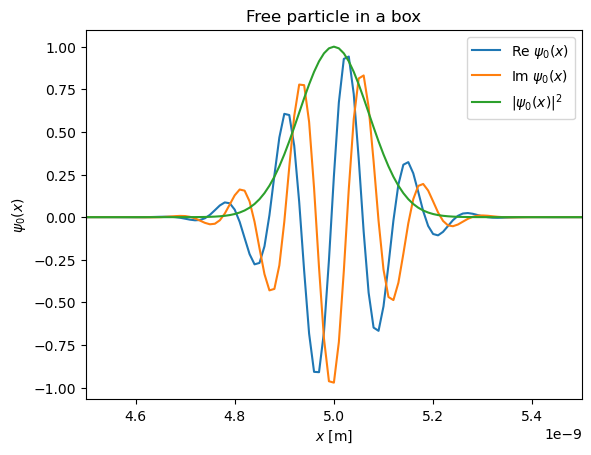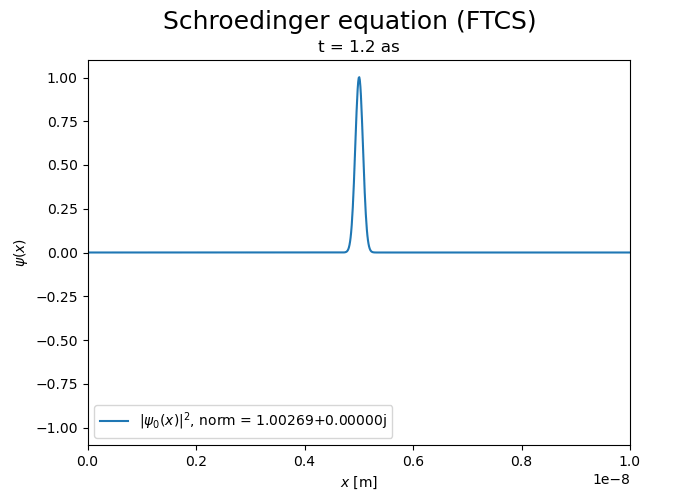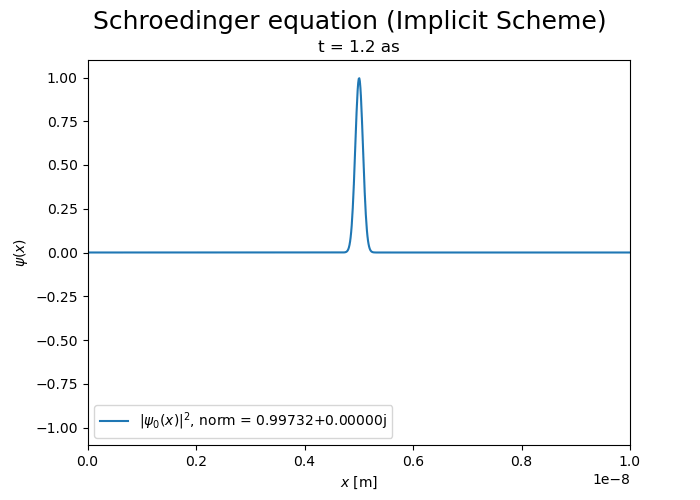Lecture Materials
Time dependent Schrödinger equation#
Time evolution of free particle wave function#
The time-dependent Schrödinger equation reads
e.g. for a free particle it reads
Formal solution be written as
with \(\hat{U}(t) = e^{-\frac{it}{\hbar} \hat{H}}\) being the time evolution operator. It is a unitary operator \(U^\dagger U = \hat{I}\), therefore, the norm of the wave function \(|\psi|^2\) is conserved.
We can study time evolution by successively applying approximate \(\hat{U}(\Delta t)\) over small time intervals. We can use the same schemes we learned for solving PDEs such as wave equation. The only difference is that now we are dealing with complex-valued functions.
FTCS scheme#
Such an operator is not unitary since
If \(U\) is applied to an energy eigenstate \(\psi_l\), such that \(\hat{H} \psi_l = E_l \psi_l\), we get
where \(\lambda_l = \left[1 - \frac{i \Delta t E_l}{\hbar} \right]\). Since \(|\lambda_l| > 1\), the method is unstable.
Implicit scheme#
We apply the approximation of the FTCS scheme to the inverse of \(\hat{U}(\Delta t)\). This implies
The operator is also non-unitary. The method is stable because
but the method does not conserve the norm of the wave function.
Crank-Nicholson scheme#
Crank-Nicholson scheme takes the combination of FTCS and implicit schemes. This corresponds to a rational approximation of \(\hat{U}(\Delta t)\):
This operator is unitary (for an hermitian \(\hat{H}\)), \(U^\dagger U = U U^\dagger\), and conserves the norm of the wave function.
Let us consider the particle in a box of length \(L\). We thus have boundary conditions \(\psi(0) = \psi(L) = 0\).
Given some initial wave function \(\psi(x)\), we can numerically integrate the Schrödinger equation to study the time evolution of the wave function.
Let us write the equation in a form:
We can now use the central difference approximation for \(\partial^2 \psi / \partial x^2\):
This gives us discretized wave function in coordinate space, in full analogy to the heat equation that we studied before. The only difference is that now we are dealing with complex-valued functions.
We now need to apply the prescription for time evolution. The options are:
FTCS scheme
or
Implicit scheme
Crank-Nicholson scheme
To preserve unitarity it makes sense to apply Crank-Nicholson scheme. In this case we need to solve the tridiagonal system of equations at each time step.
Implementation#
Let us implement the time evolution of a free particle wave function using the difference schemes.
me = 9.1094e-31 # Mass of electron in kg
hbar = 1.0546e-34 # Planck's constant over 2*pi
# Single Crank-Nicholson scheme iteration for the Schroedinger equation
# psi is a complex-valued wave function discretized in space
# r = i * h * hbar / (2*m*a^2)
# scheme: 0 - FTCS, 1 - implicit, 2 - Crank-Nicholson
def schrodinger_finitediff_iteration(psi, r, scheme = 2):
N = len(psi) - 1
psinew = np.empty_like(psi, dtype=np.cdouble)
# Boundary conditions
psinew[0] = psi[0]
psinew[N] = psi[N]
if (scheme == 0):
for i in range(1,N):
psinew[i] = psi[i] + r * (psi[i+1] - 2 * psi[i] + psi[i-1])
elif (scheme == 1):
d = np.full(N-1, 1 + 2*r)
ud = np.full(N-1, -r)
ld = np.full(N-1, -r)
# Implicit scheme matrix
v = np.array(psi[1:N])
v[0] += r * psi[0]
v[N-2] += r * psi[N]
# Solve tridiagonal system
psinew[1:N] = linsolve_tridiagonal(d, ld, ud, v)
else:
d = np.full(N-1, 2*(1+r))
ud = np.full(N-1, -r)
ld = np.full(N-1, -r)
# Crank-Nicolson explicit step
v = psi[1:N]*2*(1-r) + psi[:-2]*r + psi[2:]*r
v[0] += r * psi[0]
v[N-2] += r * psi[N]
# Solve tridiagonal system
psinew[1:N] = linsolve_tridiagonal(d, ld, ud, v)
return psinew
def schrodinger_finitediff_solve(psi0, h, nsteps, a, m = me, scheme = 2):
psi = psi0.copy()
r = 1j * h * hbar / (2 * m * a**2)
for i in range(nsteps):
psi = schrodinger_finitediff_iteration(psi, r, scheme)
return psi
Initial condition is a Gaussian wave packet moving to the right.
L = 1e-8 # m
x0 = L / 2.
sig = 1e-10 # m
kappa = 5e10 # m^-1
# Number of grid points
N = 1000
dx = L / N
# Initial wave function
def psi0(x):
return np.exp(-(x-x0)**2/(2*sig**2))*np.exp(1j*kappa*x)
xk = []
psi = np.zeros([N+1],dtype=np.cdouble)
for k in range(N+1):
x = dx * k
xk.append(x)
#print(x," ",x0," ", psi0(x))
psi[k] = psi0(x)
psi[0] = 0
psi[N] = 0
norm0 = integral_psi2(psi, dx)
import matplotlib.pyplot as plt
plt.title("Free particle in a box")
plt.xlabel('${x}$ [m]')
plt.ylabel('${\psi_0(x)}$')
plt.xlim(L/2 - 0.05*L,L/2 + 0.05*L)
plt.plot([dx*k for k in range(N+1)], np.real(psi), label="Re ${\psi_0(x)}$")
plt.plot([dx*k for k in range(N+1)], np.imag(psi), label="Im ${\psi_0(x)}$")
plt.plot([dx*k for k in range(N+1)], np.abs(psi)**2, label="$|{\psi_0(x)|^2}$")
plt.legend()
plt.show()

Now integrate over time
FTCS scheme#
xk = []
psi = np.zeros([N+1],dtype=np.cdouble)
for k in range(N+1):
x = dx * k
xk.append(x)
#print(x," ",x0," ", psi0(x))
psi[k] = psi0(x)
psi[0] = 0
psi[N] = 0
current_time = 0.
h = 1e-19
nsteps = 18
scheme = 0 # 0 - FTCS, 1 - implicit, 2 - Crank-Nicholson
for i in range(100):
psi = schrodinger_finitediff_solve(psi, h, nsteps, dx, me, scheme)
current_time += h * nsteps

The divergence of the FTCS scheme is evident.
Implicit scheme#
Implicit scheme is more stable but it does not conserve the norm of the wave function, which decreases over time.

Crank-Nicholson scheme#
Crank-Nicholson scheme is a second-order accurate scheme that is unconditionally stable and conserves the norm of the wave function.


